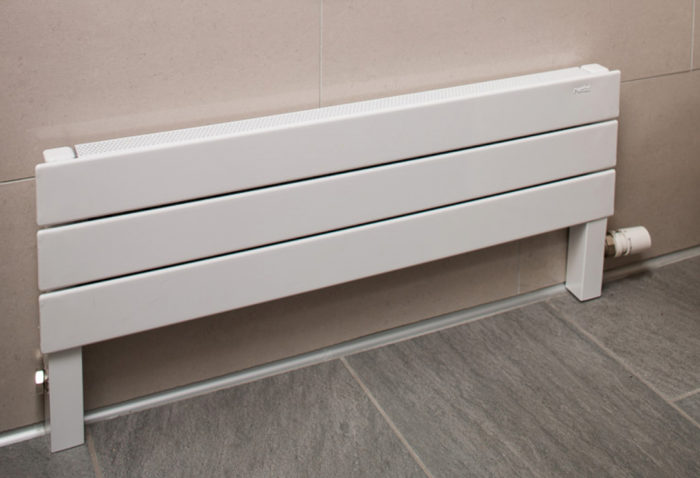
Image Credit: Runtal
Green builders, preparing for a fossil-fuel-free future, are busy building all-electric homes. Most of these homes are heated and cooled by minisplit heat pumps. Occasionally, though, a builder who’s worried about uneven heat distribution in a home with ductless minisplits will post a question on GBA suggesting the use of an air-to-water heat pump hooked up to a hydronic distribution system.
Although these systems are quite rare, a few brave pioneers have installed them, and GBA has documented their efforts with a series of articles. (See, for example, “Air-to-Water Heat Pumps” and “Split-System Heat-Pump Water Heaters.”)
One of the many energy experts who’s been investigating air-to-water heat pumps is Jake Marin, the program manager for HVAC at Efficiency Vermont. (Marin helped develop Vermont’s first incentive program for ductless minisplits.) On February 8, 2018, at the Better Buildings By Design conference in Burlington, Vermont, Marin gave a presentation on air-to-water heat pumps called “Are We There Yet?”
We’re still looking for the perfect heating and cooling system
The first question Marin addressed was, “What’s wrong with ductless minisplits?”
Marin told the Burlington audience, “Ductless minisplits aren’t a silver bullet. They have some limitations. They have the same comfort issues inherent to any point-source heater. They don’t allow system integration — they can’t be integrated with the rest of your HVAC system. Many people have aesthetic objections, calling them ‘warts on the wall.’ And anyone who wants more than one zone finds that the multi-zone systems have poorer performance than single-zone units.”
Marin also pointed out that the systems aren’t very intuitive. “People don’t know how to use their remote control,” he said. “And if the…
Weekly Newsletter
Get building science and energy efficiency advice, plus special offers, in your inbox.

This article is only available to GBA Prime Members
Sign up for a free trial and get instant access to this article as well as GBA’s complete library of premium articles and construction details.
Start Free TrialAlready a member? Log in





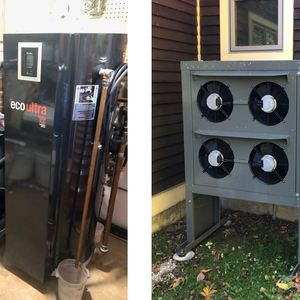
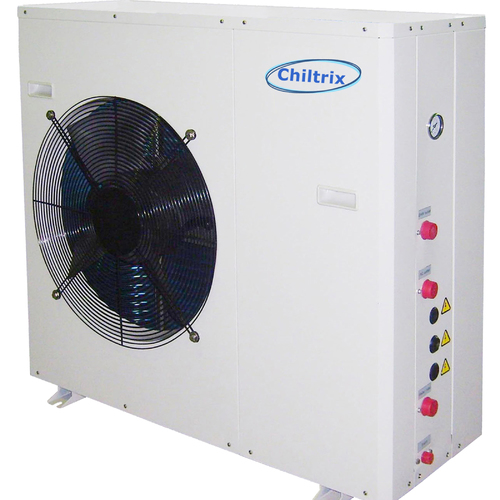
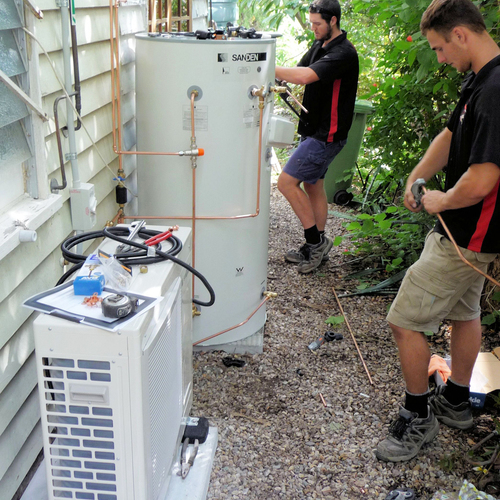
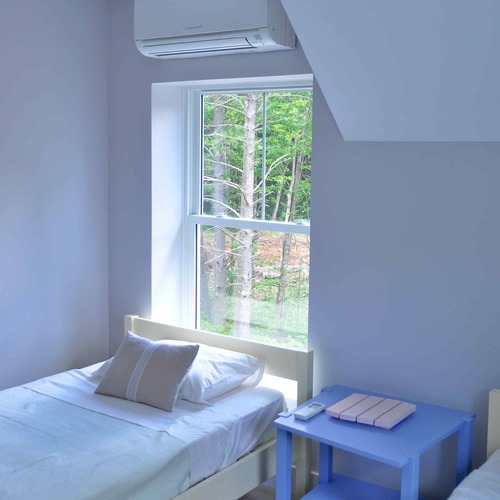






14 Comments
Sanden
We are investigating hooking the Sanden HPWH to a hydronic heating loop so it can provide both domestic hot water and heating. I'll report back.
Two Points
The performance rating is a problem. I recently HERS rated a house with a Chiltrix and all I had to work with was manufacturer COP. I knew that this wasn't really reflective of it's seasonal performance, something made clear by the fact that the homeowner/builder wasn't currently seeing the performance he had hoped for during the single digit temps we were having. I am hoping to work with this customer next winter to get some better monitoring data.
Also, I've been thinking a lot about air-to-water lately because of the logic I've been applying to HVAC. To invoke Einstein, HVAC should be as simple as possible, but not simpler. I have arrived here because of seeing to many high performance homes with a mechanical room that looks like it belongs in a nuclear submarine, and thinking "this can't be right, it certainly can't be affordable." My current food for thought is that It seems to me there are exactly two things you cannot avoid doing in even the most high performance (electric) home. Concentrating heat into a tank of water for domestic use and exchanging air in each individual space for ventilation. So in my simple fantasy house, everything else that is needed should be provided through these two unavoidable systems in an elegant fashion. An air-to-water HP seems critical to this general concept. Thoughts?
Response to Andy Kosick
Andy,
I agree that we need to make sure that a home is well ventilated. Balanced ventilation systems do an excellent job. One thing I've learned over the years is that you want dedicated ventilation ductwork. Avoid the temptation to use ventilation ductwork to deliver space heat! It's a dangerous temptation.
Many GBA readers have built homes that are comfortably heated and cooled with two ductless minisplits. These homes are simple. If you like simple, it's hard to beat that approach.
Many people have been tempted to use their domestic hot water tank for space heating. You can do it if you want -- but it makes your mechanical room look like a nuclear submarine, and you're trying to avoid that. So put in a Marathon water heater or a heat-pump water heater, along with PV if you have an unshaded south-facing roof and a solar-friendly utility, and you're done.
Retrofits vs. new construction
Most existing hydronic heating systems are so oversized they can still deliver design-day heat to the zones with water cooler than 140F water, but most won't cut it with 120F water. Having to upgrade the heat emitters makes it a more expensive proposition for retrofits.
But it's pretty easy to design-in cheap radiation capable of design-day heat at temps well under 120F for new construction.
Slab-on-grade with PEX embedded in the first floor slab, and low-temp air coils (doesn't have to be a high-mount wall coil with the mini-split type apperance- there are many optionjs) for micro-zoning rooms without slab floors can be reasonably inexpensive and designed to work well for both heating and cooling. Micro-zoning with air coils will be more expensive up front than fin-tube baseboard but substantially cheaper than low-temp heated floors. With a central buffer tank it can also be substantially more efficient than short-cycling a ductless mini-split on a micro-load room.
Latent cooling with chilled water below the indoor dew point can work too, but it adds another layer of design and control complexity. It can still make sense to do the bulk of the latent cooling with a ductless mini-split located in a high-volume zone/space, distributing the dry air with ventilation system recirculation, even if the hydronic coils are doing the bulk of the sensible cooling of the cooling zones.
I don't believe either Andy or Martin has ever seen the insides of a nuclear sub. ( Amm i rong? :-) ) Even a ridiculously micro-zoned hydronic heating system based on a buffer tank or water heater has complexity not even remotely like that of a submarine's drive systems. (I have a relative who has spent her career as as a team member refueling nuclear subs. She can't share pictures or talk about too many details, but I trust her that the mechanical rooms are not even remotely like the typical multi-zone home heating system.)
A single or 2-3 zone hydronic system can be pretty compact, whether it's based on a water heater or a boiler or buffer tank on a reversible chiller. Putting it on a water heater only adds one pump and a heat exchanger over what typical boiler-based system needs. Single zone 2-pump 1 heat exchanger water heater solutions that look simpler and take less space than traditional old school cast iron boiler based systems. But even micro-zoned systems be that simple with some forethought:
Micro zoning with hydronic coils from a buffer tank can be controlled with the fan coil's blower controls local to the and ONE pump driving a loop. When the room is calling for more heat the blower is on, when it's not the water flows-through delivering very little heat to the room. This is nothing like the (totally imaginary) nuclear sub paradigm. This is HTP's vision of what it can look like:
http://www.htproducts.com/images/house-fan-coil.png
This can work with heated or chilled water from any source, either direct from a modulating reversible chiller like the Chilltrix, or from a buffer tank (with any variety of heat/coolth sources, including non-modulating hydronic heat pumps) or a water heater, modulating condensing boiler, etc. It's a lot easier to route &/or hide a single pair of pipes than it is for any ducted distribution system.
Domestic hot water distribution systems with home-runs to manifolds (for efficiency) or domestic hot water recirculation system often exceed that level of plumbing complexity.
Response to Dana Dorsett
Dana,
Since Andy was the first one to introduce the nuclear submarine analogy, I'll let him defend it.
You're correct that designing and installing a residential hydronic system is significantly less complicated than installing mechanical equipment on a Trident sub. That said, there is something to be said for radical simplicity. For more information on this issue, see Simplicity versus Complexity.
HERS Rating Approach for Air-to-Water Systems?
Andy Kosick, can you provide any advice I can pass on to my HERS rater for modeling our ATW system? For the preliminary HERS rating, he guessed at HSPF/SEER numbers for the equipment assuming we could eventually get these numbers from the manufacturer. But, those ratings don't map well to this type of setup and Nordic isn't going to attempt a testing program to measure them. I believe the rater will be using the REM/Rate package. Thanks!
My attempt
I tried very hard to make an air to water radiant system work for my new home. I wanted the comfort radiant systems provide and the heat pump efficiency. I talked to Chilltrix and others with similar systems. My main problem with them is that they didn’t have any real test data that showed how the systems performed in real life and it appeared that the way the systems were designed there was likely to be a lot of short cycling. Sanden has by far the best real life test data. Washington State University did 2 studies and Sanden has been running air to water radiant system testing in Washington for quite some time with long-term data collection. I even went to a 2-hour seminar with Sanden on how to use their HPWH for radiant systems. I have a stupidly large spread sheet that I put together to try to prove to myself that I could get the comfort at the same long term cost – installation plus 10-year operation cost. I failed.
That said, I really think the Sanden system can work at comparable or better cost in the right situations. What I learned:
• As others have pointed out, return temperature to the water tank is very important. It needs to be as low as possible, which means a well-designed radiant floor system with the right flooring. Panel radiators don’t work.
• Slab on grade reduces the cost upcharge of above ground floor systems like gypcrete or warmboard and helps make the accounting math work.
• The Sanden system works better for a higher efficiency home. The sizing of the system is important to keep costs down and allow the system to run most efficiently.
• Get rid of the peak loads with an electric booster unit integrated into the design. If you look at the heat degree days for your area you then can design your system so that the booster comes on very seldom but extends the overall capacity of the system.
• Sanden has developed a design using a Taco X block pump that is really great. It gives a level of control other systems don’t have and provides the separation between DHW and floor heat.
• The system works more efficiently in a household that uses a lot of domestic hot water. The cold-water intake boosts the overall efficiency.
• Sanden uses CO2 as a refrigerant which is great for the planet and causes it to operate differently than other HWHPs.
• The equipment is very well designed and has been in use in Asia for quite some time. They also produce a high percentage of compressor parts for the US auto industry. I had no worries about durability.
If my home had a lower peak heat load and was constructed slab on grade this system would have worked for me at a price comparable to other systems. That would have even been true also if I would have used a zoned system with radiant heat on the first floor and a mini-split upstairs. Let me know if anyone wants more information and I’ll try to provide it.
Kevin, I'm in Portland, OR and trying to determine whether I can make the Sanden work in a combi capacity for DHW + main floor staple-up radiant and basement slab radiant.
I'd appreciate any details you can offer that might help us with what sounds like a decision similar to yours.
short cyling
> Chilltrix ... likely to be a lot of short cycling.
Given that hydronic systems can be used with buffer tanks that prevent them from ever short-cycling, I'm curious how you came to this conclusion.
> Can be used by an electric utility for demand-response purposes
I'd add that they can also be used by the homeowner for similar things, without utility involvement.
Without buffering, I'd consider air-to-water heat pumps far less interesting.
This is a dead end
"Marin predicted, “Low temperature distribution is the future of hydronic systems.”"
Unfortunately, hydronic systems are not the future for heating low energy houses.
tell that to my clients.
Thanks for the well written article. Do you have any updates on any of the air to water heat pumps since May, 2018? In your article of January, 2016, you stated that some of these heat pumps such as the Chiltrix and SpacePak had not third party testing done to verify their statistics in terms of COP. I am currently considering getting a heat pump for our home (on grid) in Waterford, VT which currently uses propane and radiant floors for most of the heating and has a zone for an indirect water heater. I am thinking of using PV panels to generate the power for the heat pump and regular electrical use.
John Ajamie
John,
Sorry, I don't have any updates on this topic. But here's some advice: if you are interested in installing an air-to-water heat pump in Vermont, you should definitely call up Efficiency Vermont and see if you can get any consulting help from Jake Marin, the specialist mentioned in my article.
For anyone who happens on this article looking for an update, below is a link to a report on an installation in Vermont.
https://www.greenbuildingadvisor.com/article/air-to-water-heat-pump-retrofit
Log in or become a member to post a comment.
Sign up Log in